Ireland
Families Along the Goulburn
19 07 23 14:00 Filed in: Jim
Recently we discovered a bit more about the Molesworth branch of our dad’s family. Down the rabbit hole we went.
It took weeks to piece together the snippets of information we had. We doubled checked information, discarded red herrings, created a timeline. We complained about the way names appeared and reappeared in different generations. We cut and pasted a colour coded chart. Finally, gradually, the stories came into focus in our minds.
Our story begins in Ireland.
Four families: McCormacks, Fords, Hamiltons and Ryans
Three of the families, the McCormacks. the Fords and the Ryans, all Catholics, all emigrated about 1848 from Southern Ireland: Limerick, Galway and Tipperary
The fourth family, the Hamiltons, were Protestants, of Scottish Irish heritage. They emigrated from Antrim, Northern Ireland, also in 1848.
The Northern Irish Hamiltons arrived with some money, ready to buy land. But
our Southern IrIsh were probably driven out by the general economic turmoil and devastation caused by the Irish Potato Famine of 1845-1852.
At that time, the vast majority of the Irish Catholic population had little or no access to land ownership and many lived in appalling poverty.
Ninety percent of the land in Ireland was owned by Protestant landowners, who rented it out in small parcels to Irish tenant farmers. Already poor and dependent on the potato crop, Irish families starved when successive harvests failed, due to Potato Blight. As a result, Irish people emigrated in large numbers, land hungry and ready to and make their fortunes.
The colony the McCormacks, Fords, Hamiltons and Ryans arrived and settled in, had been ‘opened up’ by the squatters coming down from north of the Murray and inland from Portland. The Aboriginal tribes had been largely dispossessed, vast fortunes had been made, and the landed aristocracy had emerged as a powerful force in the burgeoning colony.
It is both expected and fascinating to see our Irish immigrant forbears’ land acquisition and prosperity mirrored, in the opening up of land for settlement in Victoria. This took place over several decades, primarily through a series of land acts, designed to break up the vast holdings of the squatters and encourage agricultural development, population growth, and the establishment of communities.
Between 1865 and 1890 Land Acts enabled land to be acquired at a fair price, and paid off in instalments. Specified improvements had to be made such as fencing, clearing and cultivation.
As we will see, our Irish families also benefitted from the growth and prosperity stemming from the Gold Rush. In 1851 gold was discovered in Ballarat, leading to the 1850s Gold Rush, a transformative event in Victorian history.
The colony grew rapidly in both population and economic power and our families, among others, took full advantage of the opportunities offered.
They set about the serious business of acquiring property supplying the new, lucrative, growing market with their produce. Country towns around them grew and with increased wealth, substantial civic buildings and churches were built. Railways and roads were constructed providing quicker and easier access to markets and facilitating social and family connections.
It would have been an exciting time for our four families, as they bought and developed their land holdings and participated in the civic life of the Colony of Victoria, with its own Lieutenant-Governor and elected Victorian Legislative Council.
During the first fifteen years after arriving in the colony, our four Irish Families became two couples.
1 James Hamilton and Bridget Ryan
The protestant Hamilton family from Northern Ireland comprised only a mother and son. We know that James Hamilton’s father had recently died. James was in his late teens, when he and his mother emigrated to Port Phillip, with enough capital to acquire a property in the colony. They chose Upper Plenty, which at that time was a rural area.
The Ryan family also emigrated about 1848.
About seven years later, in 1855, James Hamilton married Bridget Ryan. Bridget was a Catholic. Sue and I know something of this quandary, being daughters of a similar “mixed marriage”. The wedding was held on a property “Richland” near the Hamilton’s place at Upper Plenty. The property belonged to Mr David Johnston
Archbishop Little, who is also related to these four families and has written about them, has a bit to say about this marriage:
“… the marriage of James and Bridget was a truly valid Catholic marriage in the eyes of the Church.”
What he means here is that James would have agreed to the children of the marriage being brought up Catholics. He certainly followed through with this, even driving his wife and children to church on Sundays. Two of their daughters later became nuns.
James and Bridget stayed on for a further twelve years in Upper Plenty, where the first six of their children were born. These children included Charles, Grace, Johanna and Kate. Johanna was our Great Grandmother.
Then, in 1866, they acquired “Cremona Estate”, near present day Molesworth. They ran dairy and beef cattle and grew cereals on the rich
river flats.
Cremona homestead was "situated on the southern concave side of a great sweeping arc of the Goulburn river ….. it fronts the Whanregarwen road distant some three miles east from the present township of Molesworth" 1866:
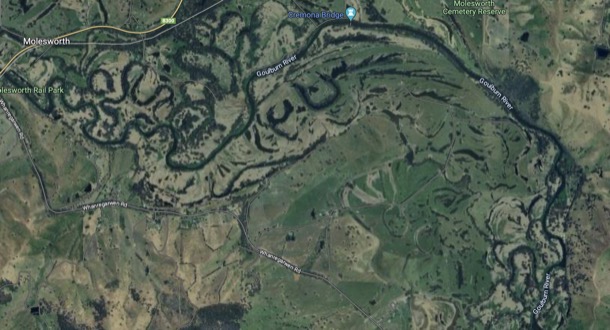
Six further children, another five of them girls, were born at Cremona, before Bridget’s death, at the age of 56, in 1889.
Archbishop Little writes glowingly of life at Cremona, and of the three eldest Hamilton girls in particular. He describes them as “charming, refined, eligible and capable young ladies.” He describes the children’s education. An in-house private tutor taught them Art, Music and Painting, as well as academic subjects. But they all helped out on the farm as well, including the older girls, Grace, Johanna and Kate.
2 John McCormack Snr and Jane Ford
We don’t know the initial activities of the McCormack and Ford families, until, in 1850, two years after landing in Port Phillip, John McCormack (Senior) married Jane Ford at St Francis Church on the corner of Lonsdale and Elizabeth streets in Melbourne. Both had been in their late twenties and unmarried when they emigrated.
St Francis church today, the oldest still operating Catholic church in Victoria:
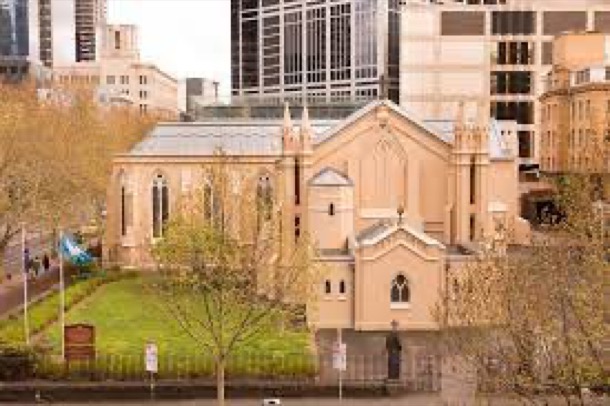
The couple settled near present day Beveridge, renting a property “Red Barn”. The property was very near the main road from Melbourne to Sydney. The family worked hard and developed a dairy herd, specialising in cheese, which they initially sold to passing diggers on their way to the goldfields.
Red Barn Lane today:
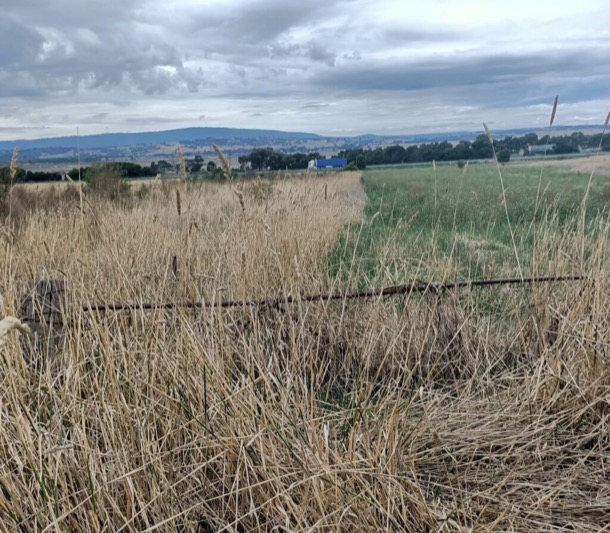
There was money to be made, so much, that the couple were later able to settle their sons on properties along the Goulburn River.
The first, of these, in 1876, was the eldest, James McCormack, then aged 18. The property, called Tallarook House, (later renamed Landscape), was at Tallarook, a hundred kilometres from Mebourne. James was unmarried at this stage and Tallarook House remained without a mistress for a further twelve years. Clearly, James was very involved in the community. He was elected as a councillor for the Shire of Seymour in 1887.
"Landscape" today:
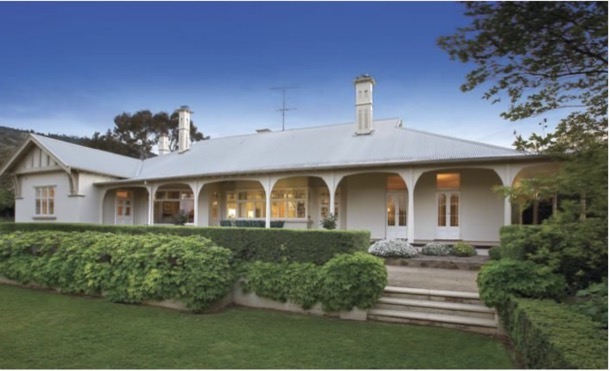
"Landscape" interior:

The second McCormack to be settled along the Goulburn River, was John Jnr. That property, acquired in 1886, called Balham Hill, was near Molesworth. John also became a councillor, for Yea Shire.
Balham Hill:
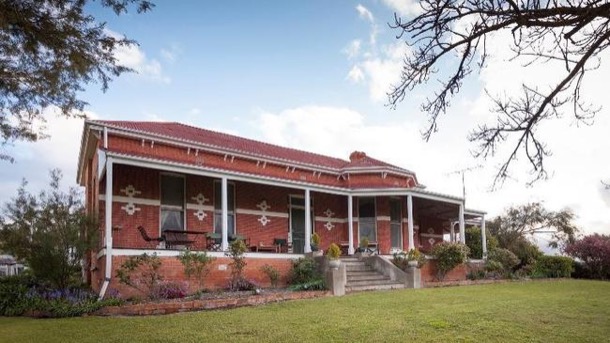
Balham Hill property:
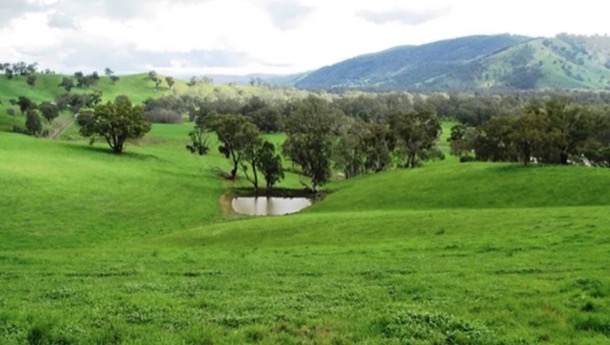
The Big Romance
So now we have three properties along the Goulburn. James and Bridget Hamilton’s Cremona and John McCormack’s Balham Hill, both near Molesworth, and James McCormack’s Tallarook House, twelve miles away.
The Hamilton girls, Grace, Johanna and Kate probably had met the McCormack boys, James, John Jnr and their brother Michael, at church. They were all Catholics.
The Hamiltons and McCormacks were a natural social fit: all pasturalists and Catholics of Irish extraction.
Archbishop Little tells us that the “Hamilton girls” stabled their horses at Tallarook House when catching or meeting the trains, and “made eyes at the McCormack boys”.
The roads between the Upper Goulburn and the railhead at Tallarook, had been completed by 1880, and the railway from Tallarook to Yea was being built from 1883. So we suppose that the road from the Upper Goulburn to Tallarook would have been a substantial one, about the time the girls were using it. Tallarook was where farm produce, etc was taken to put on the train for the markets in Melbourne.
But it’s a long way from Molesworth to Tallarook. Were they driven in a carriage of some sort, accompanied by workers from Cremona? Did they ride their own horses all that way? It was too far for a day trip. Where did they stay? And had the Hamilton girls’ parents met the McCormack boys’ parents, who lived quite a long way away, at Beveridge?
It’s a love story we can only speculate about.
But, ultimately, three Hamilton girls married three McCormack boys.
The most important to us, was Johanna Hamilton, later called Joan, our great grandmother, who married John McCormack Jnr of Balham Hill, in 1888.
Her sister, Grace, married James McCormack of Tallarook House in 1890
And Kate was the third sister, who married Michael McCormack. They settled initially in Berwick, and later Benalla.
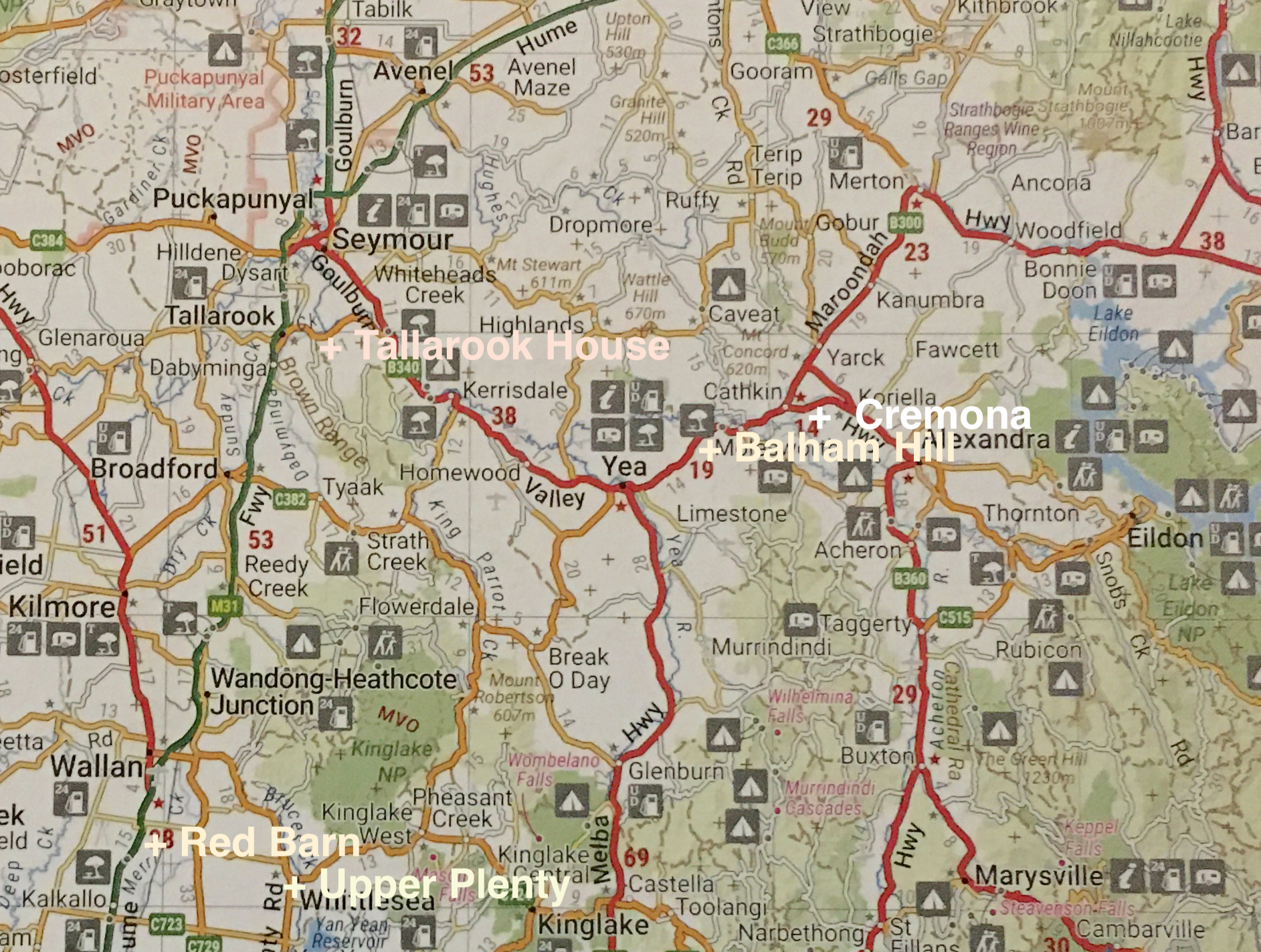

It took weeks to piece together the snippets of information we had. We doubled checked information, discarded red herrings, created a timeline. We complained about the way names appeared and reappeared in different generations. We cut and pasted a colour coded chart. Finally, gradually, the stories came into focus in our minds.
Our story begins in Ireland.
Four families: McCormacks, Fords, Hamiltons and Ryans
Three of the families, the McCormacks. the Fords and the Ryans, all Catholics, all emigrated about 1848 from Southern Ireland: Limerick, Galway and Tipperary
The fourth family, the Hamiltons, were Protestants, of Scottish Irish heritage. They emigrated from Antrim, Northern Ireland, also in 1848.
The Northern Irish Hamiltons arrived with some money, ready to buy land. But
our Southern IrIsh were probably driven out by the general economic turmoil and devastation caused by the Irish Potato Famine of 1845-1852.
At that time, the vast majority of the Irish Catholic population had little or no access to land ownership and many lived in appalling poverty.
Ninety percent of the land in Ireland was owned by Protestant landowners, who rented it out in small parcels to Irish tenant farmers. Already poor and dependent on the potato crop, Irish families starved when successive harvests failed, due to Potato Blight. As a result, Irish people emigrated in large numbers, land hungry and ready to and make their fortunes.
The colony the McCormacks, Fords, Hamiltons and Ryans arrived and settled in, had been ‘opened up’ by the squatters coming down from north of the Murray and inland from Portland. The Aboriginal tribes had been largely dispossessed, vast fortunes had been made, and the landed aristocracy had emerged as a powerful force in the burgeoning colony.
It is both expected and fascinating to see our Irish immigrant forbears’ land acquisition and prosperity mirrored, in the opening up of land for settlement in Victoria. This took place over several decades, primarily through a series of land acts, designed to break up the vast holdings of the squatters and encourage agricultural development, population growth, and the establishment of communities.
Between 1865 and 1890 Land Acts enabled land to be acquired at a fair price, and paid off in instalments. Specified improvements had to be made such as fencing, clearing and cultivation.
As we will see, our Irish families also benefitted from the growth and prosperity stemming from the Gold Rush. In 1851 gold was discovered in Ballarat, leading to the 1850s Gold Rush, a transformative event in Victorian history.
The colony grew rapidly in both population and economic power and our families, among others, took full advantage of the opportunities offered.
They set about the serious business of acquiring property supplying the new, lucrative, growing market with their produce. Country towns around them grew and with increased wealth, substantial civic buildings and churches were built. Railways and roads were constructed providing quicker and easier access to markets and facilitating social and family connections.
It would have been an exciting time for our four families, as they bought and developed their land holdings and participated in the civic life of the Colony of Victoria, with its own Lieutenant-Governor and elected Victorian Legislative Council.
During the first fifteen years after arriving in the colony, our four Irish Families became two couples.
1 James Hamilton and Bridget Ryan
The protestant Hamilton family from Northern Ireland comprised only a mother and son. We know that James Hamilton’s father had recently died. James was in his late teens, when he and his mother emigrated to Port Phillip, with enough capital to acquire a property in the colony. They chose Upper Plenty, which at that time was a rural area.
The Ryan family also emigrated about 1848.
About seven years later, in 1855, James Hamilton married Bridget Ryan. Bridget was a Catholic. Sue and I know something of this quandary, being daughters of a similar “mixed marriage”. The wedding was held on a property “Richland” near the Hamilton’s place at Upper Plenty. The property belonged to Mr David Johnston
Archbishop Little, who is also related to these four families and has written about them, has a bit to say about this marriage:
“… the marriage of James and Bridget was a truly valid Catholic marriage in the eyes of the Church.”
What he means here is that James would have agreed to the children of the marriage being brought up Catholics. He certainly followed through with this, even driving his wife and children to church on Sundays. Two of their daughters later became nuns.
James and Bridget stayed on for a further twelve years in Upper Plenty, where the first six of their children were born. These children included Charles, Grace, Johanna and Kate. Johanna was our Great Grandmother.
Then, in 1866, they acquired “Cremona Estate”, near present day Molesworth. They ran dairy and beef cattle and grew cereals on the rich
river flats.
Cremona homestead was "situated on the southern concave side of a great sweeping arc of the Goulburn river ….. it fronts the Whanregarwen road distant some three miles east from the present township of Molesworth" 1866:

Six further children, another five of them girls, were born at Cremona, before Bridget’s death, at the age of 56, in 1889.
Archbishop Little writes glowingly of life at Cremona, and of the three eldest Hamilton girls in particular. He describes them as “charming, refined, eligible and capable young ladies.” He describes the children’s education. An in-house private tutor taught them Art, Music and Painting, as well as academic subjects. But they all helped out on the farm as well, including the older girls, Grace, Johanna and Kate.
2 John McCormack Snr and Jane Ford
We don’t know the initial activities of the McCormack and Ford families, until, in 1850, two years after landing in Port Phillip, John McCormack (Senior) married Jane Ford at St Francis Church on the corner of Lonsdale and Elizabeth streets in Melbourne. Both had been in their late twenties and unmarried when they emigrated.
St Francis church today, the oldest still operating Catholic church in Victoria:

The couple settled near present day Beveridge, renting a property “Red Barn”. The property was very near the main road from Melbourne to Sydney. The family worked hard and developed a dairy herd, specialising in cheese, which they initially sold to passing diggers on their way to the goldfields.
Red Barn Lane today:

There was money to be made, so much, that the couple were later able to settle their sons on properties along the Goulburn River.
The first, of these, in 1876, was the eldest, James McCormack, then aged 18. The property, called Tallarook House, (later renamed Landscape), was at Tallarook, a hundred kilometres from Mebourne. James was unmarried at this stage and Tallarook House remained without a mistress for a further twelve years. Clearly, James was very involved in the community. He was elected as a councillor for the Shire of Seymour in 1887.
"Landscape" today:

"Landscape" interior:

The second McCormack to be settled along the Goulburn River, was John Jnr. That property, acquired in 1886, called Balham Hill, was near Molesworth. John also became a councillor, for Yea Shire.
Balham Hill:

Balham Hill property:

The Big Romance
So now we have three properties along the Goulburn. James and Bridget Hamilton’s Cremona and John McCormack’s Balham Hill, both near Molesworth, and James McCormack’s Tallarook House, twelve miles away.
The Hamilton girls, Grace, Johanna and Kate probably had met the McCormack boys, James, John Jnr and their brother Michael, at church. They were all Catholics.
The Hamiltons and McCormacks were a natural social fit: all pasturalists and Catholics of Irish extraction.
Archbishop Little tells us that the “Hamilton girls” stabled their horses at Tallarook House when catching or meeting the trains, and “made eyes at the McCormack boys”.
The roads between the Upper Goulburn and the railhead at Tallarook, had been completed by 1880, and the railway from Tallarook to Yea was being built from 1883. So we suppose that the road from the Upper Goulburn to Tallarook would have been a substantial one, about the time the girls were using it. Tallarook was where farm produce, etc was taken to put on the train for the markets in Melbourne.
But it’s a long way from Molesworth to Tallarook. Were they driven in a carriage of some sort, accompanied by workers from Cremona? Did they ride their own horses all that way? It was too far for a day trip. Where did they stay? And had the Hamilton girls’ parents met the McCormack boys’ parents, who lived quite a long way away, at Beveridge?
It’s a love story we can only speculate about.
But, ultimately, three Hamilton girls married three McCormack boys.
The most important to us, was Johanna Hamilton, later called Joan, our great grandmother, who married John McCormack Jnr of Balham Hill, in 1888.
Her sister, Grace, married James McCormack of Tallarook House in 1890
And Kate was the third sister, who married Michael McCormack. They settled initially in Berwick, and later Benalla.


Comments
The Pakenham Bourkes 1839 - 2017 Part One.
19 04 17 14:58 Filed in: Jim
Michael and Catherine Bourke of Shanagolden, County Limerick, Ireland, our great, great grandparents were part of the very early settlement of Victoria. They were sponsored as assisted migrants.
New South Wales had been settled as a convict colony in 1788, when the first fleet arrived. Over the next fifty years, many convicts were transported there, and many English free settlers chose to try their luck in that distant land. By the 1830s, there was clearly a need for more immigrants in the colony. Not only were there three men to every woman, but the balance of convicts to free settlers was all out of whack. There were not enough reliable, trustworthy labourers to work on all the properties that had been developed, especially all the sheep stations.
A committee was set up to address this issue. It looked like a win-win situation with England, where the population had outgrown the rural jobs available. It should have been easy to entice the right kind of working people to settle in New South Wales. But America was also expanding, and was a fifth of the distance. It was hard to persuade people to undertake a perilous sea voyage to New South Wales instead.
A scheme was set up, whereby young country women of good character would have their sea passage paid for, and be guaranteed a job as a servant in rural New South Wales.
Predictably the people whose task was to head off into the countryside and interview young unmarried women of good character, took shortcuts, and, by the sound of it, simply herded up the “mere sweepings of the streets of London” who were all too happy to take the money.
On one large ship, the David Scott, 226 single females came out to New South Wales. Mr Marshall, Royal Navy, the hapless “superintendent” of the ship said of the 226 “there were not more than twenty-five that I would consider suited for country servants”. Furthermore the David Scott was a very large ship and there were more than fifty men in the crew. They seemed to have been totally out of control ‘they .. had unrestrained intercourse with them during the voyage” (in this context ‘intercourse’ just means anything from unsupervised conversation to what it means today) ‘I do not allude of course to the whole of the women, but to upwards of forty of them, whose abandoned and outrageous conduct kept the ship in a continual state of alarm during the whole passage’
The committee overseeing this scheme were supposed to have “personally questioned every female for the purpose of ascertaining her age, occupation and qualifications in other respects for the colony. Either the powers of dissimulation (lying) possessed by abandoned females of the lowest grade must be very great indeed and must be well backed by forgery, or the gentlemen of the London committee must have been marvellously unskilled in discriminating character.”
After this debacle only small ships were used, and many other checks and balances were put in place, including the selection of potential migrants. It is in this context that, in 1838, Governor Richard Bourke contacted his friend, Thomas Spring -Rice, Baron of Monteagle, and landlord to young Michael Bourke of Foynes Island Shanagolden, County Limerick, Ireland.

Governor Bourke asked Spring-Rice to carefully select suitable people to participate in a scheme to emigrate to New South Wales, and, in particular, the newly colonised area of Port Phillip. In 1839, 13 families who had been Spring-Rice’s tenants, including Michael and his new wife Catherine, emigrated to Australia on the Aliquis. Most settled in the Port Phillip area. By 1858, about 800 ‘Monteagle emigrants” had settled in the new colony.
Monteagle county in New South Wales, containing the towns of Forbes and Bathurst, is named after this Irish nobleman.
So Michael and Catherine Bourke, our Irish great, great grandparents, and founders of the Australian branch of the Bourke family, arrived in Australia on St Patricks Day, March 17th in 1839.
On the ship's list, Michael, 24, is listed as an “agriculturalist”, with his unnamed wife aged 22, though perhaps she was only 20. Catherine had in fact been a dairy maid back in Limerick.
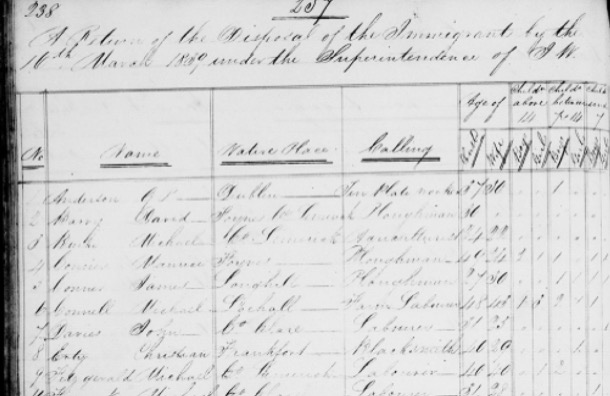
Close up of the Aliquis passenger list. Michael Bourke (misspelt as Burke) third on the list.
In an interview, carried out when Catherine was a very old lady, she said that they were married in Cork City, just before they left for New South Wales on the ship Aliquis,
And yet, when they arrived at Sydney, on March 2nd 1839, Michael and Catherine lost no time in seeking a priest to bless their marriage, and on Saint Patrick’s day, the ‘Banns of Marriage’ were read for the first time. It was at St Mary’s cathedral in Sydney where, 22 days later, the couple made their Vows of Marriage, on April 8th before Fr Francis Murphy and their friends from their home parish of Shanagolden, who had traveled with them from Ireland.
Work in Sydney was scarce and the ship John Barry took them along with most of their fellow travellers to the newly laid out town of Melbourne. Michael and Catherine spent their early days in Moonee Ponds, managing a dairy farm. The first three sons, James, John and Thomas were born there.
Just four years before Michael and Catherine Bourke arrived in what was then the Colony of N.S.W., Melbourne had begun its ramshackle development. John Batman, entrepreneur and settler, signed a treaty with aboriginal occupants of the Port Philip District, the Kulin nation. He promptly claimed over 500,000 acres north and west of present day Melbourne and also famously declared the present site of Melbourne’s CBD, as the place for a village. The then Governor of the Colony of NSW, Governor Bourke, became concerned at the unruly and illegal occupation of land, and took charge, declaring all settlements invalid. He appointed Captain Lonsdale to represent him and run the settlement of Port Philip. Fees for grazing rights to squatters were imposed, and Governor Bourke approved Hoddle’s plan for the streets of Melbourne. This is the new world which Michael and Catherine entered, as they stepped off the boat to begin their new life.
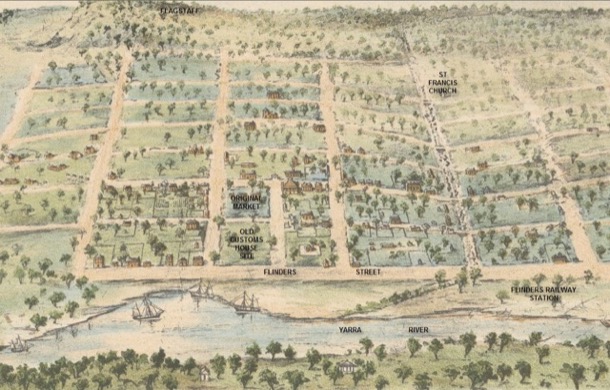
Hand drawn map of very early Melbourne, around 1837
The family moved to near Pakenham in 1844, with their friends the Nevilles, who had come out on the Aliquis with them from Limerick. Under the partnership names of Neville and Bourke, they settled in the Toomuc Valley area, taking up the “Minton’s Creek” run, which extended towards Upper Beaconsfield, 12,800 acres, about 5 square kilometres. Here, our great, great grandfather, Michael, was born in their ‘slab hut’ home in 1844.
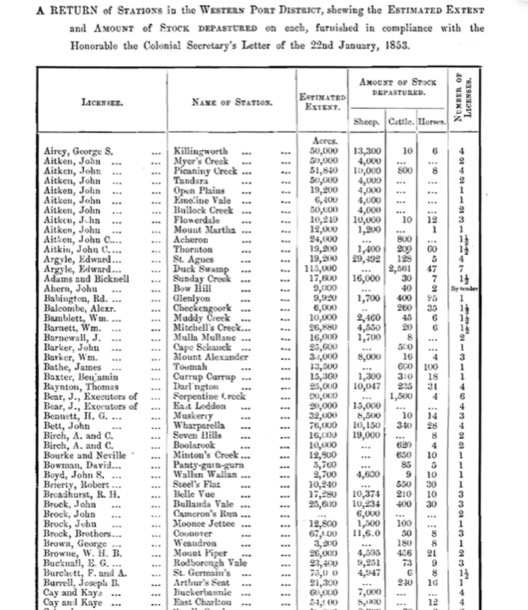
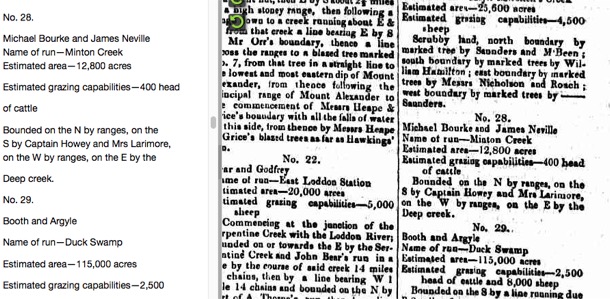
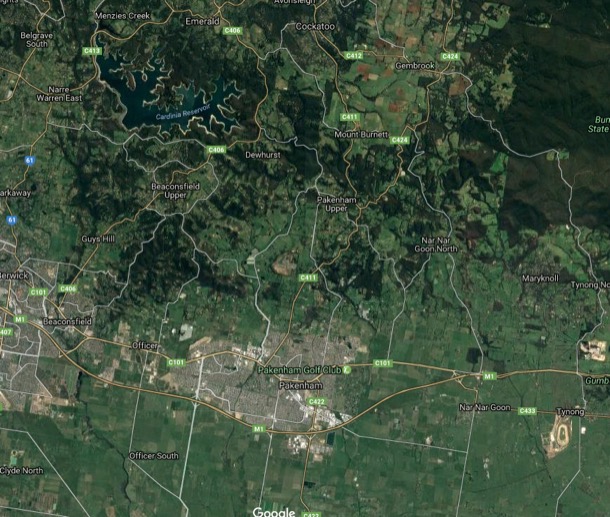
Minton's Creek Run covered the whole of present day Pakenham Upper
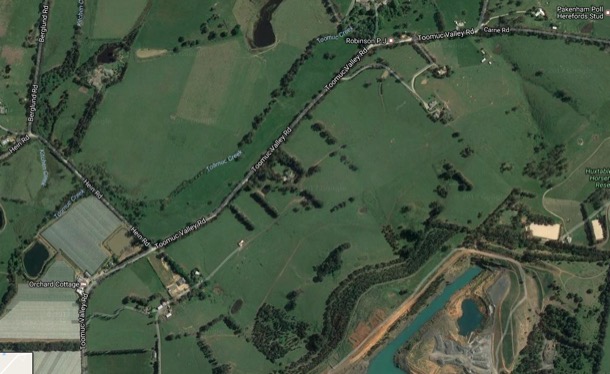
The Minton's Creek house site was in the centre of this aerial photo
In 1850, the Bourkes bought the Latrobe Inn, a hotel on the main Gippsland Road, where the Toomuc Creek (also known as Bourke’s Creek) crosses the main road. It became known as Bourke’s Hotel. Catherine and the seven children they had by then moved to the hotel to manage it, while Michael stayed at the station.
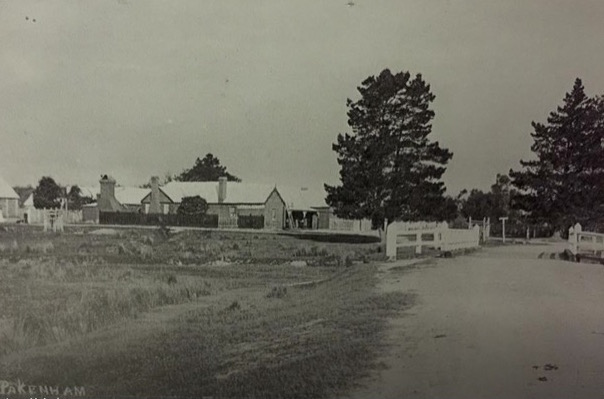
Bourke's hotel
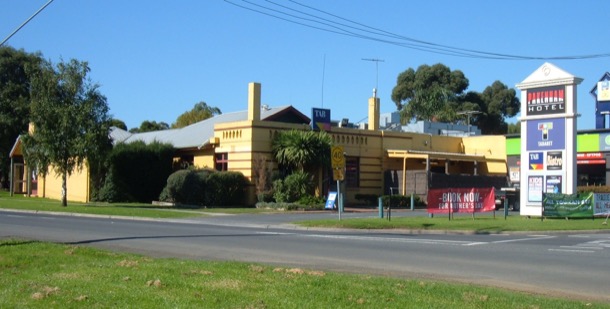
Only the original chimney stands today.
In February, 1851, after a prolonged drought, a massive bushfire covered a quarter of what is now Victoria. The smoke blew on strong hot winds, wreathing Northern Tasmania in thick smoke. It became known as Black Thursday. The story goes that Michael fought the blaze, first with water, and then milk from the dairy.
Word reached him that the hotel itself was surrounded by fire. He galloped down to Pakenham, and there he found that Catherine and the children had hidden in the Toomuc Creek bed and had escaped the blaze, and that the hotel itself had not burnt.

from Black Thursday, a painting in the State Library
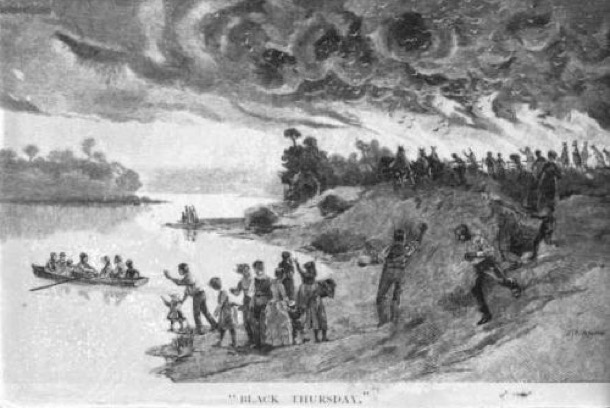
They restocked the property, and, in an 1853 census, it was reported that Bourke and Neville had 650 cattle and ten horses on their 12,800 acres.
Bourke’s Hotel became one of the best known stopping places on the way to Gippsland. Later it became the Princes Highway Hotel and its chimney is still there today.
It was a real hub of the district. It was the polling station and the post office for the area, and Michael Bourke was postmaster at Pakenham for 30 years. After his death, in 1877, Catherine, and unmarried daughter Cecelia, continued to run the post office.
In his 1942 book Memoirs of a Stockman, Harry Huntington Peck wrote:
Old Mrs. Bourke who was the landlady of the Pakenham hotel at the bridge over the Toomuc creek for so many years was an institution of the district. She was most popular with the Gippsland travellers and drovers as she took pains to make all visitors comfortable. Her fine sons David and Daniel prospered as graziers and bought good properties, the one Llowalong originally part of Bushy Park on the Avon near Stratford, and the other Old Monomeith, where the next generation Hughie and Michael, trading as Bourke Bros., are today the largest regular suppliers of baby beef to Newmarket, are well known as the owners of show teams of first-class hunters and hacks, and of late years, have been very successful in principal hurdle and steeplechase races.
It was at Bourke’s Hotel that the remainder of the children were born. There were fifteen in all, but two died in infancy.
Gradually the family grew to adulthood, and, when large areas of land were thrown open for “selection”, all the boys in turn gained properties.
Some of them are still in the hands of their descendants.
New South Wales had been settled as a convict colony in 1788, when the first fleet arrived. Over the next fifty years, many convicts were transported there, and many English free settlers chose to try their luck in that distant land. By the 1830s, there was clearly a need for more immigrants in the colony. Not only were there three men to every woman, but the balance of convicts to free settlers was all out of whack. There were not enough reliable, trustworthy labourers to work on all the properties that had been developed, especially all the sheep stations.
A committee was set up to address this issue. It looked like a win-win situation with England, where the population had outgrown the rural jobs available. It should have been easy to entice the right kind of working people to settle in New South Wales. But America was also expanding, and was a fifth of the distance. It was hard to persuade people to undertake a perilous sea voyage to New South Wales instead.
A scheme was set up, whereby young country women of good character would have their sea passage paid for, and be guaranteed a job as a servant in rural New South Wales.
Predictably the people whose task was to head off into the countryside and interview young unmarried women of good character, took shortcuts, and, by the sound of it, simply herded up the “mere sweepings of the streets of London” who were all too happy to take the money.
On one large ship, the David Scott, 226 single females came out to New South Wales. Mr Marshall, Royal Navy, the hapless “superintendent” of the ship said of the 226 “there were not more than twenty-five that I would consider suited for country servants”. Furthermore the David Scott was a very large ship and there were more than fifty men in the crew. They seemed to have been totally out of control ‘they .. had unrestrained intercourse with them during the voyage” (in this context ‘intercourse’ just means anything from unsupervised conversation to what it means today) ‘I do not allude of course to the whole of the women, but to upwards of forty of them, whose abandoned and outrageous conduct kept the ship in a continual state of alarm during the whole passage’
The committee overseeing this scheme were supposed to have “personally questioned every female for the purpose of ascertaining her age, occupation and qualifications in other respects for the colony. Either the powers of dissimulation (lying) possessed by abandoned females of the lowest grade must be very great indeed and must be well backed by forgery, or the gentlemen of the London committee must have been marvellously unskilled in discriminating character.”
After this debacle only small ships were used, and many other checks and balances were put in place, including the selection of potential migrants. It is in this context that, in 1838, Governor Richard Bourke contacted his friend, Thomas Spring -Rice, Baron of Monteagle, and landlord to young Michael Bourke of Foynes Island Shanagolden, County Limerick, Ireland.

Governor Bourke asked Spring-Rice to carefully select suitable people to participate in a scheme to emigrate to New South Wales, and, in particular, the newly colonised area of Port Phillip. In 1839, 13 families who had been Spring-Rice’s tenants, including Michael and his new wife Catherine, emigrated to Australia on the Aliquis. Most settled in the Port Phillip area. By 1858, about 800 ‘Monteagle emigrants” had settled in the new colony.
Monteagle county in New South Wales, containing the towns of Forbes and Bathurst, is named after this Irish nobleman.
So Michael and Catherine Bourke, our Irish great, great grandparents, and founders of the Australian branch of the Bourke family, arrived in Australia on St Patricks Day, March 17th in 1839.
On the ship's list, Michael, 24, is listed as an “agriculturalist”, with his unnamed wife aged 22, though perhaps she was only 20. Catherine had in fact been a dairy maid back in Limerick.

Close up of the Aliquis passenger list. Michael Bourke (misspelt as Burke) third on the list.
In an interview, carried out when Catherine was a very old lady, she said that they were married in Cork City, just before they left for New South Wales on the ship Aliquis,
And yet, when they arrived at Sydney, on March 2nd 1839, Michael and Catherine lost no time in seeking a priest to bless their marriage, and on Saint Patrick’s day, the ‘Banns of Marriage’ were read for the first time. It was at St Mary’s cathedral in Sydney where, 22 days later, the couple made their Vows of Marriage, on April 8th before Fr Francis Murphy and their friends from their home parish of Shanagolden, who had traveled with them from Ireland.
Work in Sydney was scarce and the ship John Barry took them along with most of their fellow travellers to the newly laid out town of Melbourne. Michael and Catherine spent their early days in Moonee Ponds, managing a dairy farm. The first three sons, James, John and Thomas were born there.
Just four years before Michael and Catherine Bourke arrived in what was then the Colony of N.S.W., Melbourne had begun its ramshackle development. John Batman, entrepreneur and settler, signed a treaty with aboriginal occupants of the Port Philip District, the Kulin nation. He promptly claimed over 500,000 acres north and west of present day Melbourne and also famously declared the present site of Melbourne’s CBD, as the place for a village. The then Governor of the Colony of NSW, Governor Bourke, became concerned at the unruly and illegal occupation of land, and took charge, declaring all settlements invalid. He appointed Captain Lonsdale to represent him and run the settlement of Port Philip. Fees for grazing rights to squatters were imposed, and Governor Bourke approved Hoddle’s plan for the streets of Melbourne. This is the new world which Michael and Catherine entered, as they stepped off the boat to begin their new life.

Hand drawn map of very early Melbourne, around 1837
The family moved to near Pakenham in 1844, with their friends the Nevilles, who had come out on the Aliquis with them from Limerick. Under the partnership names of Neville and Bourke, they settled in the Toomuc Valley area, taking up the “Minton’s Creek” run, which extended towards Upper Beaconsfield, 12,800 acres, about 5 square kilometres. Here, our great, great grandfather, Michael, was born in their ‘slab hut’ home in 1844.



Minton's Creek Run covered the whole of present day Pakenham Upper

The Minton's Creek house site was in the centre of this aerial photo
In 1850, the Bourkes bought the Latrobe Inn, a hotel on the main Gippsland Road, where the Toomuc Creek (also known as Bourke’s Creek) crosses the main road. It became known as Bourke’s Hotel. Catherine and the seven children they had by then moved to the hotel to manage it, while Michael stayed at the station.

Bourke's hotel

Only the original chimney stands today.
In February, 1851, after a prolonged drought, a massive bushfire covered a quarter of what is now Victoria. The smoke blew on strong hot winds, wreathing Northern Tasmania in thick smoke. It became known as Black Thursday. The story goes that Michael fought the blaze, first with water, and then milk from the dairy.
Word reached him that the hotel itself was surrounded by fire. He galloped down to Pakenham, and there he found that Catherine and the children had hidden in the Toomuc Creek bed and had escaped the blaze, and that the hotel itself had not burnt.

from Black Thursday, a painting in the State Library

They restocked the property, and, in an 1853 census, it was reported that Bourke and Neville had 650 cattle and ten horses on their 12,800 acres.
Bourke’s Hotel became one of the best known stopping places on the way to Gippsland. Later it became the Princes Highway Hotel and its chimney is still there today.
It was a real hub of the district. It was the polling station and the post office for the area, and Michael Bourke was postmaster at Pakenham for 30 years. After his death, in 1877, Catherine, and unmarried daughter Cecelia, continued to run the post office.
In his 1942 book Memoirs of a Stockman, Harry Huntington Peck wrote:
Old Mrs. Bourke who was the landlady of the Pakenham hotel at the bridge over the Toomuc creek for so many years was an institution of the district. She was most popular with the Gippsland travellers and drovers as she took pains to make all visitors comfortable. Her fine sons David and Daniel prospered as graziers and bought good properties, the one Llowalong originally part of Bushy Park on the Avon near Stratford, and the other Old Monomeith, where the next generation Hughie and Michael, trading as Bourke Bros., are today the largest regular suppliers of baby beef to Newmarket, are well known as the owners of show teams of first-class hunters and hacks, and of late years, have been very successful in principal hurdle and steeplechase races.
It was at Bourke’s Hotel that the remainder of the children were born. There were fifteen in all, but two died in infancy.
Gradually the family grew to adulthood, and, when large areas of land were thrown open for “selection”, all the boys in turn gained properties.
Some of them are still in the hands of their descendants.

